|
|
|
|
WORKSHEET
THE COLOR WHITE & SYNCRETISM IN JAPAN
These are deep waters -- the merger of Buddhist and Shinto deities is a topic of great depth. I have refrained from swimming in these waters for a long time. It is very confusing and requires great attention. But it is something that I MUST FINALLY DO. It is now written prominently in my “to do“ ledger.
Fox-snake-dragon mythology in Japan's religious tradition is perhaps one of the most perplexing, confusing, and convoluted topics imaginable. Lafcadio Hearn (1850 - 1904), writing at the end of the 19th century, declared the topic "ghostly zoology," and essentially gave up on it, as have most modern scholars. Yet, such mythology opens the door to the great syncretic nature of the Japanese religious experience. Below I present some interesting elements of this “blended” experience. This page is only starting point. I claim no special knowledge. Herein I simply catalog my findings, and hope someone will step forward to help more fully explore the topic.
CAST OF CHARACTERS
Foxes, snakes, dragons, Hindu-Buddhist-Shinto deities.
- Shintō. Oinari 稲荷 (god/goddess of rice) and his/her foxes; plus Ugajin 宇賀神, an obscure local kami on Mt. Hiei that the Tendai sect merged with Benzaiten to create Uga Benzaiten.
- Shugendō 修験道. Mountain worship incorporating Taoist magic, Shinto beliefs, and Esoteric practices. Most of the art pieces presented below come from Shugendō strongholds and/or mountain-based Shingon temples (e.g. Tenkawa Jinja Shrine 天河神社 in Nara Prefecture and its Tenkawa Benzaiten).
- Buddhism. Benzaiten 弁財天 in her esoteric form, with snake head.
- Hinduism & Esoteric Buddhism. Dakiniten 荼吉尼天 and her white fox. She also assumes forms related to Daikokuten, the god of the five grains. Dakiniten is also closely associated with food and the rice crop.
- Esoteric Buddhism. Shōten 聖天 (aka Kangiten 歓喜天).
- WHITE COLOR. White seems to be a common element. Nearly all the above deities have messengers who are white in color. Curiously, Inari 稲荷 (Japan’s Rice Deity), Uga Benzaiten 宇賀弁財天, and Daikokuten 大黒天 (Hindu God of Five Cereals, identified with Japan’s Shinto Oo-kuninushi-no-Mikoto 大国主命) each have messengers that are WHITE in color. Inari is often associated with a white fox, as is Dakiniten of Hindu mythology, Benzaiten with a white snake, and O-Kuninushi-no-Mikoto with a white hare. Is this coincidental, or does it suggest a deeper relatedness?
Dakiniten Mandala 荼吉尼天曼荼羅. From the Heian period onward (is this correct ?), Dakiniten was invoked in various esoteric rites in Japan to gain complete mastery in human affairs, to hex one's enemies, to win favor at court, to pray for good fortune, and other matters. In Hindu mythology, the Dakini are a class of wrathful female demons who drink blood and eat human flesh, and scholars consider them acolytes of the Hindu goddess Kali. Over time the Dakini were incorporated into Vajrayana (Tantric) traditions as lower-ranking goddesses. In Japan, however, the Dakini group never gained a large following, except for one named Dakiniten (also spelled Dakini-ten). In Japan, Dakiniten is typically depicted riding a white fox. She is closely associated with food and the rice crop. She is thus, in Japan, often associated or merged with the Shinto rice god/goddess Inari (whose messenger is the fox). She also assumes forms related to Daikokuten (lord of five grains). In the 8th-century text Dainichikyōsho 大日経疏, Dainichi Buddha appears as Daikokuten in order to subdue Dakiniten 荼吉尼天. She is also closely associated with the esoteric form of the Buddhist goddess Benzaiten. See Tenkawa Benzaiten below for more details.
|
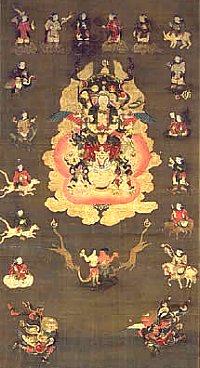
Dakiniten Mandala
荼吉尼天曼荼羅図
12-Armed, Three-Headed Dakini
Early Muromachi Era 室町時代, 15th C
Taho Collection 田万コレクション
H 82.5 cm x W 41.4 cm
Color on Silk
Osaka Municipal Museum of Art
Also known as 三天合形曼荼羅
Lit. "Mandala of Three Deva"
The three heads in above piece are:
Dakiniten 荼吉尼天
Benzaiten 弁財天
Shouten 聖天 (aka Kangiten 歓喜天)
Also known as
三面十二臂辰狐王曼荼羅
Lit. "Mandala of 3-Headed &
12-Armed Dragon-Fox King"
Various syncretic themes are blended in this mandala, including the Oinari 稲荷信 connection (Shintō) with foxes and the Hindu and Buddhist connections with Dakiniten, Kangiten, and Benzaiten. In addition, the museum says a "Black Book" from Hieizan's Myōtoku-in (比叡山明徳院) was found at the back of the mandala, giving it the name 三天合形曼荼羅 (Mandala of Three Deva), and indicating probable Shugendō influence. Most of the figures along the border are “probably” the Jūgo Dōji 十五童子 (Fifteen Sons or Disciples of Benzaiten). See Tenkawa Benzaiten below.
|
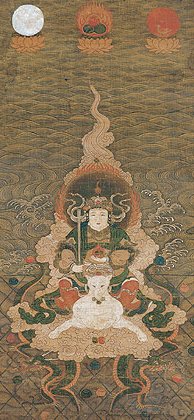
Dakiniten Hanging Scroll
Nambokucho period (1333 AD)
Ink, color, and gold on hemp
29 1/2 x 13 in. (74.9 x 33 cm)
Courtesy
Metropolitan Museum
of Art (New York)
Says Barbara B. Ford at the New York Met: "Originally a blood-sucking man-eating demoness, Dakiniten was converted by the Vairocana (Dainichi) Buddha into a powerful life-engendering deity. In the complex interaction of Buddhism, Shinto, and Taoist yin-yang practices in medieval Japan, this icon embodied near-magical powers of fecundity that were invoked not only in enthronement rituals but also in personal contexts. The mantra identified with this deity was chanted to achieve control over the mind. Medieval tales recount invocations of Dakiniten by both men and women to win position and favor at court, as well as in matters of the heart." <end quote by Barbara B. Ford>
|
|
Tenkawa Benzaiten Mandala 天川弁才天曼荼羅. Tenkawa Jinja Shrine 天河神社 in Nara Prefecture is a sacred site and practice location for Shugendō 修験道 devotees. Shugendō is a syncretic sect that combines Taoist magic, Shinto beliefs, and Estoteric doctrines. Tenkawa Jinja is also devoted to the Goddess Benzaiten, and hence is also called Tenkawa Dai-Benzaitensha. The Tenkawa Benzaiten Mandala (shown below) was used to invoke her aid for bountiful harvests and good fortune.
|
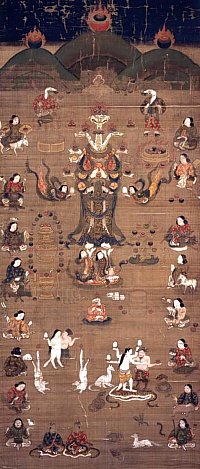
|
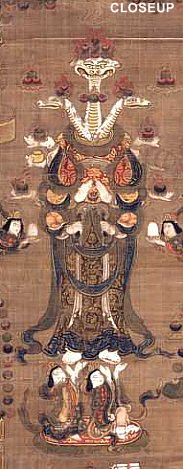
|
|
Tenkawa Benzaiten Mandala 天川弁才天曼荼羅図
Nōman-in Temple 能満院 in Sakurai City 桜井市, Nara Pref.
Muromachi Era, 1546 AD, Color on Silk, H 99.4 cm W 39.4 cm
Courtesy Treasures of Nara Prefecture | Large Photo | J-Description
At the top of the mandala are three sacred gems (hōju 宝珠) with flame nimbus (kaenkō 火焔光) shown atop three mountains. At the center of the mandala is a 10-armed Benzaiten shown in human form but with three serpent heads. Around her are the Jūgo Dōji 十五童子 (Fifteen Sons or Disciples of Benzaiten), all holding various symbolic objects. Strewn everywhere throughout the painting are images of the Hōju 宝珠 (Sacred Gem), which represent the power to expel evil, cleanse corruption, remove suffering, and grant every wish. In some esoteric traditions in Japan, this sacred jewel is said to have emerged from the head of the dragon king (Ryū-ō 竜王; dragons are a type of serpent). The snake-headed Benzaiten represents the syncretic Shinto-Buddhist deity known as Ugajin 宇賀神 or Uga Benzaiten. The foxes and male-female pairs inside the painting symbolize the merging of Oinari 稲荷 (also written Inari; he is the Japanese god of rice, his messenger is the fox) with the esoteric deity known as Dakiniten 荼吉尼天, a Hindu goddess adopted into the Buddhist pantheon. Her messenger is a white fox. Another similar piece is kept at Ishiyama-dera 石山寺, a Shingon temple in Otsu City (Shiga Pref.). Such syncretic pieces are relatively rare in Japan. The three peaks may be related to sacred Mt. Hakusan (but I am not sure). Hakusan, with its three peaks, came under the control of the syncretic Tendai shrine-multiplex at Mt. Hiei in the 12th century.
For a few more details in Japansese, see:
d.hatena.ne.jp/heisai/
geocities.jp/noharakamemushi/Koshaji/Nanki/Tenkawa.html
|
|
BENZAITEN, Snake, White Snake, Hakuja, Ugajin
In her esoteric form, Benzaiten is depicted as Uga Benzaiten. Her messenger in both orthodox and in esoteric Buddhism is the snake (or dragon, which, by definition, is a serpent), so she is sometimes shown mounted on a serpent or dragon. Said to possess a jewel (hōju 宝珠) that grants desires (see Tenkawa Benzaiten above). On days of importance to the serpent in Japan, one can find many festivals at the numerous Japanese shrines and temples dedicated to Benzaiten (Benten), in which votive pictures with serpents drawn on them are offered. It is also said that putting a cast-off snake skin in your purse/wallet will bring you wealth and property.
In artwork, Benzaiten is sometimes surrounded by white serpents, or crowned with a white serpent. Another Japanese deity, Suijin, of the Shinto pantheon, appears in some artwork in the form of a white snake. Like Benzaiten, Suijin is closely associated with water. Indeed, Benzaiten’s temples and shrines are almost invariably in the neighborhood of water -- the sea, a river, or a pond. Images of Benzaiten are also accompanied, although rarely, by a large white serpent with the head of an old man. This latter entity is called Hakuja 白じゃ (white serpent; also known as Ugajin 宇賀神), considered her companion. (Note: Unable to confirm the Japanese spelling of Hakuja.)
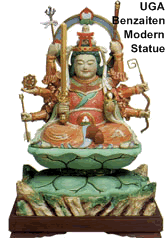 Uga Benzaiten 宇賀弁財天 Uga Benzaiten 宇賀弁財天
During Japan’s Heian era, the powerful Tendai sect on Mt. Hiei merged the Buddhist deity Benzaiten with an obscure local kami (spirit) named Ugajin (see photo at right) to create the syncretic deity known as Uga Benzaiten, a deity of good fortune and wealth. Most sources believe Ugajin is none other than Uga no Mitama, the Shinto goddess of foodstuffs mentioned in Kojiki and Nihongi, two of Japan’s earliest records. Uga no Mitama is also commonly identified with a male counterpart named Uka no Mitama, the deity of grains. This Shinto pair are further identified with Inari, the parent Shinto god/goddess of rice and agriculture, who is identified with a white fox as his/her messenger. Confused yet?
MORE CONFUSION. To create further confusion, consider this. The symbolism and roles of Benzaiten and Ugjin are very similar to those associated with Inari, as mentioned above, the parent Japanese deity of agriculture and rice. Inari is a composite diety, merged with the Hindu/Buddhist guardian deity Dakiniten, and is generally depicted riding a white fox (sometimes with white snakes in his/her hair). The similarities between Benzaiten and her white snake and the iconography of Inari/Dakiniten and the white fox are very striking.
WHITE COLOR. Curiously, Inari 稲荷 (Japan’s Rice Deity), Uga Benzaiten 宇賀弁財天, and Daikoku-ten 大黒天 (Hindu God of Five Cereals, identified with Japan’s Shinto Oo-kuninushi-no-Mikoto 大国主命) each have messengers that are WHITE in color. Inari is often associated with a white fox, as is Dakiniten of Hindu mythology, Benzaiten with a white snake, and Oo-kuninushi with a white hare. Is this coincidental, or does it suggest a deeper relatedness?
|
|